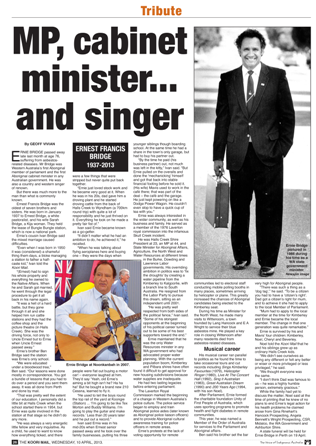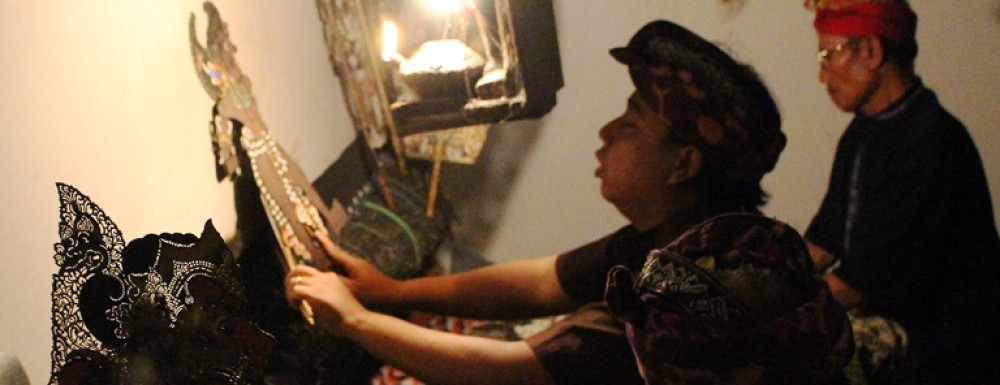TEXT BY GEOFF VIVIAN
from The Koori Mail
 Ernie Bridge passed away late last month at age 76, suffering from asbestos-related diseases. He launched legal action in WA’s Supreme Court on 15 March for damages connected with the asbestosis and mesothelioma he contracted during his many visits to the former mining town of Wittenoom.
Ernie Bridge passed away late last month at age 76, suffering from asbestos-related diseases. He launched legal action in WA’s Supreme Court on 15 March for damages connected with the asbestosis and mesothelioma he contracted during his many visits to the former mining town of Wittenoom.
Mr Bridge was best known as a country and western singer and the WA parliament’s first Aboriginal member. He was also believed to be the first Aboriginal cabinet minister in any Australian government.
But as with all people, there was much more to the man.
Ernest Francis Bridge was the oldest of seven brothers and sisters. He was born in January 1937 to Ernest Bridge, a white pastoralist, and his wife Sarah Bridge, a Kija woman. They held the lease of Bungle Bungle station which is now a national park.
Ernie’s first cousin Ivan Bridge says the mixed marriage caused difficulties.
“Even when I was born in 1950 it was (considered) a shameful thing them days, a bloke managing a station to father a half-cast kid,” Ivan says. “He had to sign his whole property and everything he owned to the Native Affairs. When they got married, he went through the legal procedure to get it all back in his name again. It was a hell of a hard battle, but they gone through it all and she helped him run cattle stations and they had the coffee shop and the picture theatre (in Halls Creek). She was the driving force, not only to Uncle Ernest but to Ernie when Uncle Ernest passed away.”
Ernie’s brother Ben Bridge says the station was Ernie’s only school.
“We were educated under a bloodwood tree,” Ben says. “Our lessons were done mostly in correspondence. You got a bundle of lessons that you had to do over a period and you sent them away. It was all done from Perth and done my mail. That was pretty well the extent of our education. I did personally a little bit at Halls Creek when the school started there in ’54, but Ernie was quite involved in the station at that stage so he didn’t do any more.”
“He was always a very energetic little fellow and very inquisitive. As a child he used to want to know how everything ticked, and there were a few things that were stripped but never quite put back together. He just loved stock work and he became very good at it. When he was in his 20s dad gave him a droving plant and he started droving cattle from the back of Halls Creek to Wyndham (a 700km round trip) with quite a lot of responsibility and he just thrived on it. Everything he took on he made a pretty fair fist of it.”
Ivan says Ernie became known as a go-getter.
“It didn’t matter what he had an ambition to do, he achieved it,” Ivan says. “When he was talking about flying aeroplanes here and buying one, they was the days when people were flat out buying a motor car! Everyone laughed at him: ‘Yeah, old Ernie’s aiming a bit high isn’t he, ha ha ha!’ But he bought a brand-new 210 Cessna, learned to fly it.
“He used to tell the boys round the top rail of the yard at Koongie (Station) … ‘I’m going to be like Tex Morton and Buddy Williams, I’m going to play the guitar and make records.’ Within less than 20 years he put out a record, he cut several tracks.”
Ivan says Ernie was in his mid-20s when Ernest senior passed away, and took over the family businesses, putting his three younger siblings though boarding school. At the same time he had a share in the town’s only garage, but had to buy his partner out.
“By the time he paid him out, not much was left in the kitty,” Ivan says. “But Ernie pulled on the overalls and done the mechanicking himself and got that back into stable financial footing before he sold it. (His wife) Mavis used to work in the café there, that was part of the deal, the café and the garage. He just kept powering on like a Dodge Power Wagon. He couldn’t even stop to have a quick cup of tea with you.”
Ernie was always interested in the wider community, as well as his business and family. He served as a member of the 1976 Laverton royal commission into the infamous Skull Creek incident.
He was Halls Creek shire president at 23, a member of parliament at 44, and minister for Aboriginal Affairs, Agriculture, The North West and Water Resources at different times in the Burke and Dowding Labor state governments. His over-riding ambition in politics was to “fix the droughts” by creating a water pipeline from the Kimberley to Kalgoorlie, with a branch line to South Australia. He resigned from the Labor party to pursue this dream, sitting as an independent til 2001.
“He was pretty well-respected from both sides of the political fence,” Ivan says. “Some of his stongest opponents at the beginning of his political career turned out to be some of his best supporters toward the end.”
Ernie maintained that he was the only water resources minister in any WA government who had advocated proper water planning. With the current population boom, Kimberley and Pilbara shires have often found it difficult to get approval for new housing sub-divisions because water supplies are not adequate.
He left two lasting legacies before entering parliament.
The Laverton Royal Commission marked the beginning of a change in Western Australia’s police culture. As a result the police service began to employ and train Aboriginal Police Aides (later known as Aboriginal Police Liason Officers or APLOS) and to provide Aboriginal cultural awareness training for police officers in remote areas.
His protests at the lack of voting opportunity for remote community dwellers led to electoral staff conducting mobile polling booths in many places, sometimes arriving by helicopter or plane. This has greatly increased the chances of Aboriginal candidates being elected to the Kimberley seat.
During his time as Minister for the North West he made numerous visits to Wittenoom, a town founded by Lang Hancock and EA Wright to service their blue asbestos mine. He played a key role in closing Wittenoom down after numerous residents succumbed to fatal asbestos-related diseases.
His musical career ran parallel to politics as he found the time to make occasional tours and cut records including “Sings Kimberley Favourites” (1979), “Helicopter Ringer” (1980); “Live At The Concert Hall” (1992); “Sing it Australian” (1983); “Great Australian Dream” (1990) and “200 Years Ago” (1994 with his son Noel).
After parliament he formed the charitable foundation Unity of First People of Australia, which uses sporting programs to promote health and combat diabetes in remote communities.
This year he was named a Member of the Order of Australia for services to the parliament and Aboriginal affairs.
Ben says his brother set the bar very high for Aboriginal people.
“There was such a thing as what you might call a dog tag,” Ben says. “To be a citizen you had to have a citizen’s right. Dad got a citizen’s right for mum, and to achieve it she had to apply to the local Member of Parliament. Mum had to apply to the local member at the time for Kimberley and Ernie became the local member. The change in that one generation was quite remarkable.”
Ernie is survived by his children Kimberley, Noel, Cheryl and Beverley.
Noel says they grew up as normal Halls Creek children.
“We didn’t see ourselves as being any different or felt any better or wiser or more privileged or less privileged,” he says. “We thought everyone was the same.”
“I don’t think Dad was famous to us – he was a highly humble person, extremely gracious.”
Noel says while the family is yet to discuss the matter, he knows of no plans to discontinue their father’s legal action against Gina Rinehart’s Hancock Prospecting, Angela Bennett’s Wright Prospecting, CSR, Midalco, the WA government and Ashburton Shire.
A State Funeral will be held for Ernie Bridge in Perth on 19 April.
This version of the article is slightly different to the edited text in The Koori Mail.
